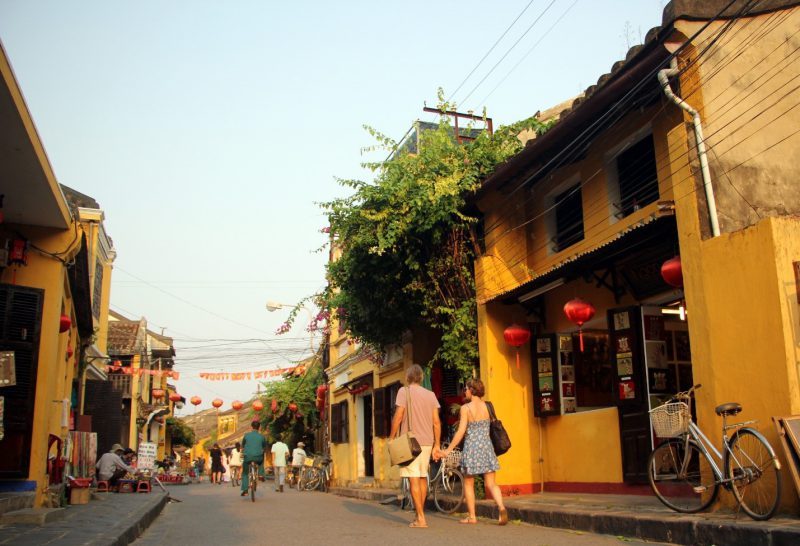Tourists are allowed at most popular tourist sites in Quang Ninh including Ha Long Bay, Yen Tu Mountain, and Tra Co National Tourism Site. Hotels, restaurants, cafes, golf courses, as well as beaches have also reopened from today.
Visitors also flock to Hoi An, the Vietnam’s central coast known for its well-preserved Ancient Town, cut through with canals.
The former port city’s melting-pot history is reflected in its architecture, a mix of eras and styles from wooden Chinese shophouses and temples to colorful French colonial buildings, ornate Vietnamese tube houses and the iconic Japanese Covered Bridge with its pagoda.
Visitors to Thanh Hoa can now visit tourist destinations in the provinces, which have re-opened since last weekend.
However, groups of tourists are not allowed to exceed ten people and must abide by measures of epidemic prevention and social distancing regulations.
Along with other tourist destinations in Thanh Hoa province, Lam Kinh Historical Site, located in Tho Xuan district, temporarily stopped receiving visitors since mid-March to prevent the spread of COVID-19.
After over a month, the destination is now ready to welcome tourists again.
Likewise, many accommodations and restaurants in Sam Son beach in Sam Son city have been preparing necessary conditions to welcome guests when the social distancing regulations were eased.
According to Vice Chairman of the People’s Committee of Sam Son city Bui Quoc Dat, the city is urgently completing tourism management plans to welcome tourists back after the social distancing period.
Similarly, two famous tourist attractions in the southern province of An Giang – Sam Mountain and Cam Mountain National Tourism Sites – have also opened their doors to tourists.
According to Tran Quoc Tuan, Vice Chairman of the Chau Doc City People’s Committee, tourists can now visit Sam Mountain Tourism Site from 9am on April 28. Earlier, the site had to close its doors since March 25 and would re-open when the epidemic is under control.
Meanwhile, Cam Mountain Tourism Site in Tinh Bien district will re-open its doors on April 29 after one month of closure, as revealed by the provincial Trade and Investment Promotion Centre.
However, tourists entering the site must strictly follow regulations on COVID-19 prevention like wearing masks, washing hands with soap or disinfectant solution and keeping a distance of at least two metres from others.
Phu Quoc and other islands off Kien Giang Province and tourist attraction sites reopened over the weekend after social distancing measures were eased.

Vietnam’s Phu Quoc is home to the world’s longest sea cable car route.
@Shutterstock
The province on Saturday allowed the resumption of hospitality and catering services.
Tourism and travel firms were asked to follow all regulations on COVID-19 prevention based on instructions from the health sector. Vietnam News Agency reported.
Related: Vietnam eases social distancing but keeps vigilance on the Covid-19 fight
Only domestic tourists and expatriates in Vietnam will be allowed to travel to Phu Quoc Island, home to some of the most beautiful beaches in Southeast Asia, and to other tourist attractions in the province.
Earlier this week, many tourism destinations in other provinces also re-opened to receive tourists ahead of the upcoming national holiday that falls on April 30, reunification day and May 1, International Labour Day.

The lists of opening attractions include the national heritage site Ghenh Da Dia (The Cliff of Stone Plates) in Phu Yen province, Phong Nha-Ke Bang National Park in Quang Binh province, My Son Sanctuary in Quang Nam province, Da Lat Night Market in Lam Dong province, together with beaches in Da Nang, Binh Dinh and Kien Giang.
However, only domestic tourists and expatriates in Vietnam will be allowed in most sites.
On the other hand, the relics and tourism sites in Hanoi have not re-opened yet but are preparing to welcome tourists back soon, like the Temple of Literature, Hoa Lo Prison and Thang Long Imperial Citadel.
@ NDO/VNA




